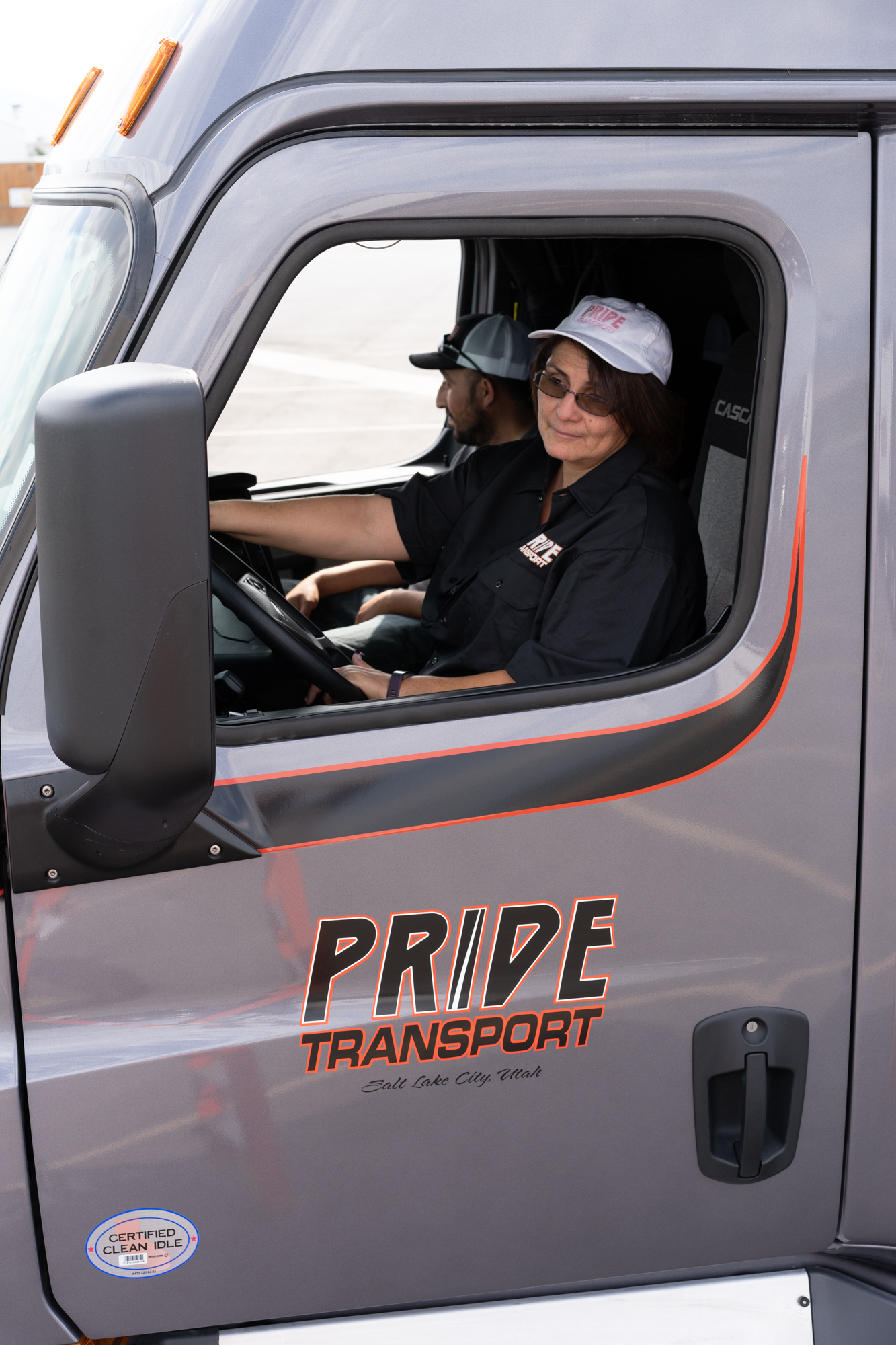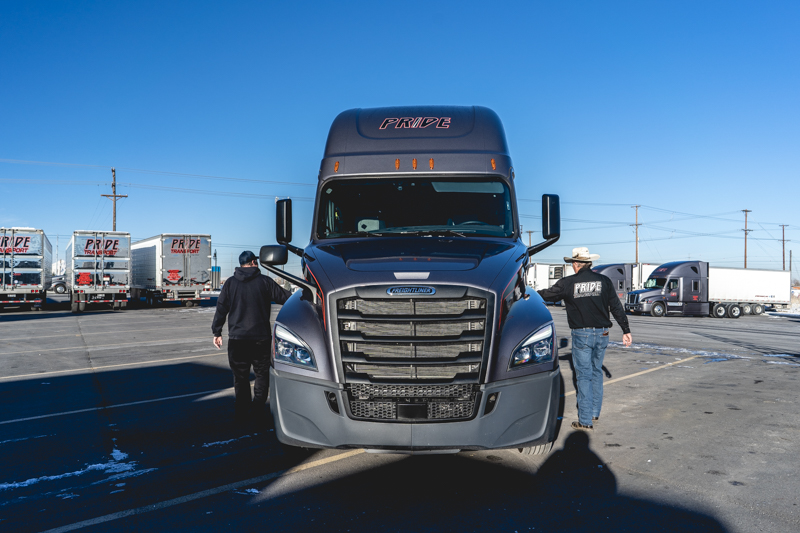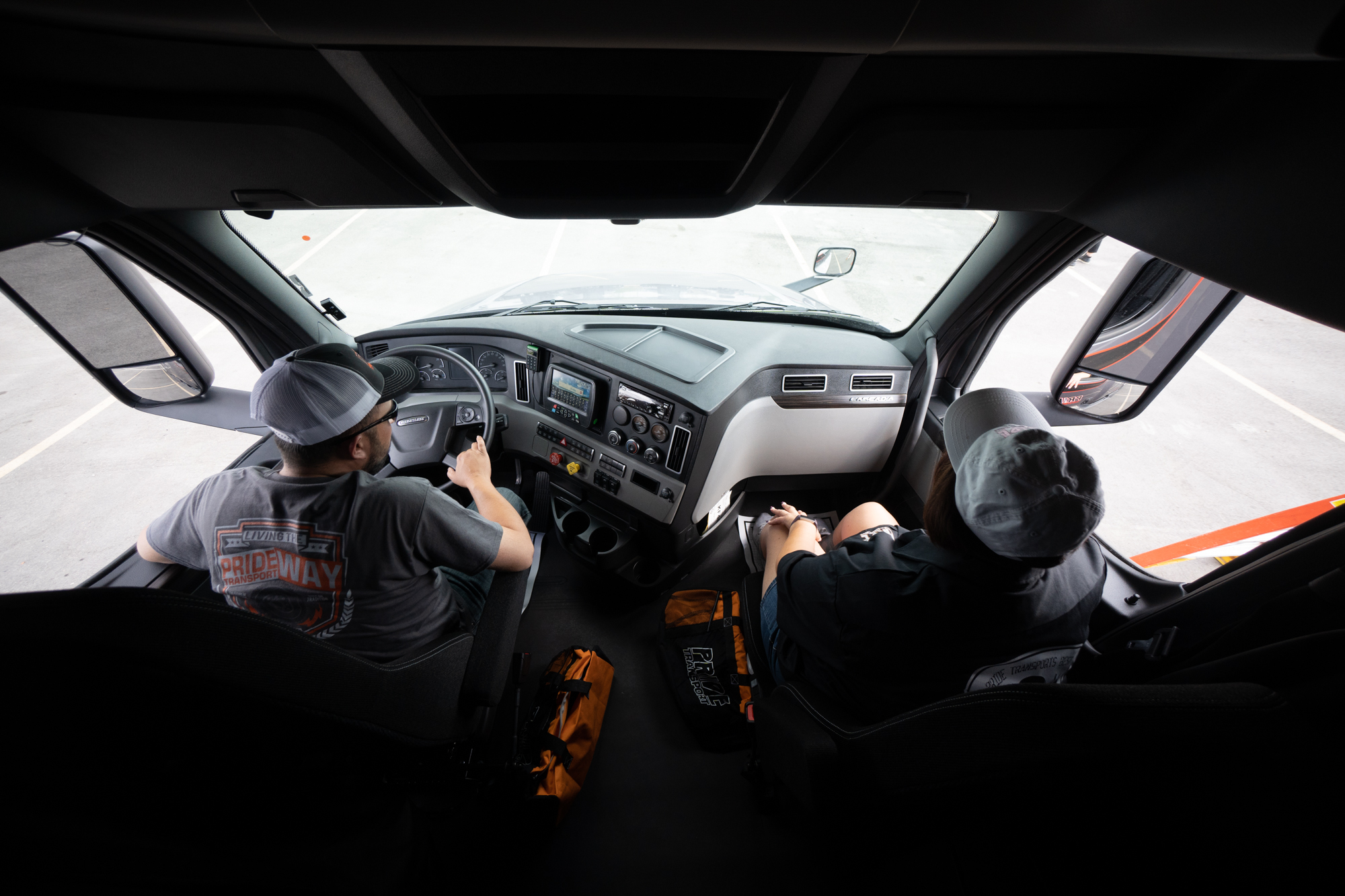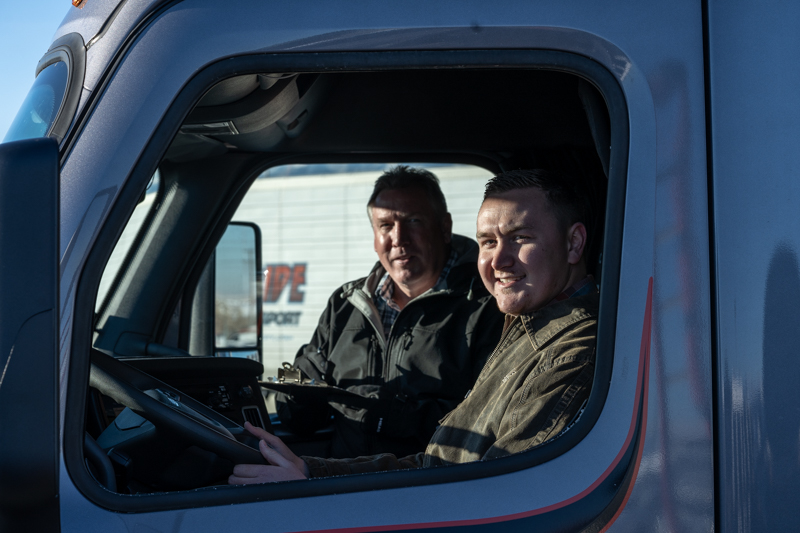by Pride Transport | Oct 03, 2025
Team truck driving is one of the ways to level up your career as a driver: more miles, more pay, and some real advantages, but also some real trade‑offs. If you’re thinking about making the jump from solo to team, here’s what to expect, and whether it might be the right fit for you.
What Is Team Truck Driving?
Team truck driving is a system where two qualified CDL holders operate one truck, alternating shifts so the vehicle keeps moving more often. It's a method designed for efficiency: while one driver rests in the sleeper berth, the other drives. This minimizes downtime, makes long hauls faster, and increases overall mileage. For companies, it's about faster delivery times. For drivers, it means potentially larger paychecks.
At Pride Transport, team driving is a strategic part of the business. Drivers can choose their partners or be matched with compatible teammates. Whether you're a solo driver looking to team up or a veteran duo, Pride offers the support and structure to succeed.

Rest, Rules, and Reality on the Road: How Team Drivers Manage Fatigue, Compliance, and Safety
Team truck driving is often talked about in terms of miles and money, but the real difference comes down to how teams handle the rhythm of rest and the requirements of the law. It’s not just about splitting shifts and swapping drivers. It’s about learning to rest in motion, staying compliant with Hours-of-Service (HOS) rules, and managing the mental and physical stress that comes with long-haul trucking. When done right, team driving keeps the wheels turning almost around the clock, but only if both drivers know how to balance sleep, safety, and the realities of life on the road.
Why Sleep Matters More Than You Think
Being well-rested isn’t optional in trucking; it’s a direct link to safety, compliance, and earning potential. The science is clear: fatigue is one of the most dangerous risks drivers face.
The National Sleep Foundation reported in 2024 that drowsy driving is involved in about 1 in 5 fatal crashes in the U.S.. That’s not just passenger cars, commercial drivers are included in that statistic. Fatigue slows reaction time, makes it harder to pay attention, and increases the chance of making critical errors.
Research backs this up. According to Geotab, drivers who get fewer than five hours of sleep in a 24-hour period are at risk of impairment similar to someone driving under the influence of alcohol. Reaction times lag, decision-making suffers, and alertness drops dramatically. Sleep Advisor adds that drivers awake for 18 straight hours function as though they had a blood alcohol concentration of 0.05 percent, while those awake for 24 hours show impairment equivalent to 0.10 percent, which is above the legal alcohol limit for driving in all 50 states.
Despite this, surveys show that most drivers underestimate fatigue. Many will avoid getting behind the wheel after drinking, but far fewer delay a trip after a poor night’s sleep. That’s where team driving can offer a safety advantage: by sharing the load, drivers reduce the temptation to push through exhaustion. But the key is whether the rest in the sleeper berth is good rest, and that’s not always easy to achieve.
The Challenge of Sleeping in Motion
Team driving sounds straightforward: one person drives while the other rests, then switches. But “rest” in this context often means trying to fall asleep in a moving truck. The road noise, vibration, braking, gear changes, and even differences in temperature inside the cab can all interfere with deep, restorative sleep.
Some drivers adapt quickly and can sleep soundly regardless of conditions. Others struggle, waking up frequently or failing to reach the deeper sleep cycles the body needs. Over time, poor rest adds up to fatigue just as surely as driving too many hours.
Many trucks may be equipped with up to date sleepers designed for comfort, thicker mattresses, climate control, and insulated cabins, but even with good equipment, drivers must train themselves to rest in motion. Earplugs, eye masks, blackout curtains, and consistent sleep routines can all help. Team drivers who prioritize sleep hygiene are the ones who thrive. Those who don’t often find team life more draining than solo driving.
Hours-of-Service Rules and How They Shape Team Driving
Federal Hours-of-Service regulations set the framework for how much a driver can work and when they must rest. These aren’t just technicalities. They affect how you plan runs, when you switch seats, and how you log rest.
The basics are straightforward: property-carrying drivers may drive up to 11 hours after 10 consecutive hours off duty, all within a 14-hour on-duty window. That 14-hour window includes all work-related tasks, not just driving, inspections, fueling, loading, and unloading all count.
For teams, the most useful rule is the split sleeper berth provision. This allows the required 10 hours off duty to be split into two qualifying periods: one of at least 7 consecutive hours in the sleeper berth and another of at least 2 consecutive hours in either the sleeper or off-duty. When combined, they count as the required 10 hours, even though the time is split.
This rule is what makes true 24/7 operation possible. One driver can log seven hours of sleeper berth rest while the other drives, then switch. Over a long run, this system keeps the truck moving almost continuously, maximizing miles and earnings while staying compliant.
It also puts pressure on drivers to make that rest count. Poor-quality rest still technically meets the legal requirement, but if you wake up groggy and impaired, you’re not safe to drive. Compliance is about more than logging hours; it’s about ensuring the rest is effective.
Risks That Don’t Show Up on the Logbook
Even with perfect log compliance, risks remain. Fatigue isn’t the only concern.
Sleep disorders such as obstructive sleep apnea (OSA) are common among commercial drivers, especially given the sedentary nature of the job and higher rates of obesity. OSA interrupts breathing during sleep, leading to poor rest quality and increased daytime drowsiness. Studies show untreated sleep apnea significantly raises crash risk. Pride Transport encourages medical screening and treatment for drivers who may be at risk, ensuring that rest is restorative and safe.
Stress and mental health are also major factors. Continuous long runs, tight delivery windows, and time away from family can wear drivers down emotionally. Monotony on the highway, combined with the constant responsibility of operating an 80,000-pound vehicle safely, adds another layer of strain. Without strategies to manage stress, staying connected with family, bringing along hobbies, taking short breaks to stretch or walk, drivers can become mentally fatigued even when they’re technically “rested.”
Finally, burnout is a real threat. The rhythm of team driving: constant motion, irregular rest, and close quarters with another driver, can wear on even experienced professionals. Burnout doesn’t happen overnight, but over weeks or months, the cumulative stress and fatigue can sap motivation, harm health, and increase mistakes.

The Importance of Compliance Beyond the Law
Compliance with FMCSA rules is non-negotiable, but smart drivers see it as more than just following the law. Staying compliant protects your CDL, shields you from fines, and keeps you and others safe. But it also directly affects earning power. A violation can sideline you, delay a load, or damage your reputation with dispatch.
Pride Transport supports compliance through well-maintained trucks, electronic logging devices (ELDs) that simplify recordkeeping, and training on how to use the split sleeper berth provision effectively. We also emphasize that compliance is about the spirit of the law, not just the letter. If you’re too tired to drive, no paycheck is worth pushing forward.
What Life Really Feels Like on the Road
When you combine these factors: the challenge of sleeping in motion, the demands of Hours-of-Service rules, and the need to stay safe and compliant, you get the real rhythm of team driving. It’s a constant cycle of driving, resting, and communicating. One moment you’re planning a fuel stop together, the next you’re trading seats at a rest area while your partner crawls into the sleeper berth.
Every decision is shared: when to stop for food, how to route around traffic, how fast to drive to meet delivery windows. Even small things like cab temperature or radio volume require negotiation. The drivers who succeed are the ones who treat team driving as a partnership, not just a job.
Pay & Income: What You Can Expect
It’s important to know current rates and what affects your take‑home.
- According to Team Truck Driver Salary data from Salary.com (mid 2025), the national average for team drivers is around $69,206/year (about $33/hour) for many positions. That can vary a lot with location, experience, routes, fleet, etc.
- Another 2025 industry report shows many team drivers make roughly $99,400/year, depending on how many weeks driven, how many miles, bonuses, etc.
- CPM rates (including solo vs team, basic freight, etc.) fall in the $0.45 to $0.85 CPM range for over‑the‑road operations, with team operations often at the higher end.
Depending on your operations, miles/week, bonus potential, you could see serious gains vs solo driving.

Frequently Asked Questions from Drivers
Do I need special licensing or training to team drive?
Not usually beyond what’s required for solo CDL‑A driving. But many fleets (including ours) expect you to have some experience first, clean driving record, and ability to adhere to team‑specific best practices (communication, rest discipline, etc.).
How is pay split between drivers?
Most teams split the pay evenly, regardless of who drove more miles in a shift. Some arrangements are based on individual miles, but those are less common. Always check with your carrier what pay structure is used.
Do I have to stop for rest breaks?
Yes, FMCSA rules apply. Even in teams, rest breaks, sleeper berth requirements, and cumulative hours rules must be followed. The sleeper berth provision gives some flexibility, but rest must satisfy regulatory requirements.
Does team driving guarantee more home time?
Not necessarily. Teams often drive longer runs, which can mean more time away from home, but potentially fewer total days off because the run completes faster or has fewer delays. How often and how long you’re home depends on the fleet, route, and whether you negotiate or are assigned recurring routes.
Is Team Driving a Good Move for You?
Team driving comes with major advantages, but it also brings unique challenges. Here’s a clear look at both sides:
|
Pros: Benefits of Team Driving |
Cons: Trade-Offs and Challenges |
|
Higher Earnings Through More Miles: Because the truck stays in motion longer, you can cover more ground in less time. That usually means bigger paychecks. The Trucker’s Report notes that team drivers average about $99,400/year, with the potential for even higher earnings depending on routes, bonuses, and schedules. |
Limited Privacy: Life on the road means sharing a cab and sleeper berth 24/7. For drivers who need alone time or personal space, this constant closeness can be draining. |
|
Premium Freight Opportunities: Shippers and carriers prefer teams for time-sensitive or expedited freight. That often translates into priority loads, steadier work, and better pay opportunities, including bonuses. |
Quality of Sleep: Resting while the truck is moving isn’t always easy. Vibration, road noise, shifting temperatures, and gear changes can make it difficult to get deep, restorative sleep. |
|
Less Idle Time: Since one driver can rest while the other is at the wheel, the truck rarely has to sit idle for long. That maximizes earning hours and reduces unproductive downtime. |
Clashing Styles & Habits: Conflicts can arise over driving speed, route choices, meal times, radio or music preferences, or even cab temperature. Mismatched habits can cause ongoing tension if not addressed early. |
|
Support & Shared Load: Team driving means you’re not alone. Beyond splitting miles, you share inspections, trip planning, communication with dispatch, and even the emotional load of long hauls. Having company in the cab can make the miles feel shorter. |
Emotional Stress & Conflict: Close quarters mean small irritations can turn into bigger issues. Stress from traffic, weather, or mechanical delays can compound the strain. Communication and patience are critical. |
|
Better Pay Structures / Incentives: Many fleets offer teams higher cents-per-mile rates, along with performance and expedited freight bonuses. Some of the top paying carriers currently advertise $0.78 to $1.02 CPM for premium team contracts. |
Burnout Risk if Mis-Managed: Even with legally required rest, the rhythm of constant operation can take a toll if drivers don’t carefully manage diet, sleep, hydration, and stress. Without discipline, burnout can creep in quickly. |
Pride Transport Thinks Team Driving Makes a Difference
Team driving isn’t for every driver, but for many it’s more than just “making more money”, it’s about making better use of your time, minimizing downtime, and getting ahead faster. It demands more coordination, more awareness of your body’s needs, and more give‑and‑take, but the upside can be substantial.
If you thrive on rhythm, on pushing the limits legally and safely, and want to maximize your earning potential, team driving could be your best move.
Pride Transport has helped many drivers make the switch, stay safe, and earn what they deserve. If you’re ready to explore team driving, we’ll help you understand the details, pair you with a teammate if you want, and get you started with the best possible support, equipment, and routes. Drive with Pride. Apply now.
